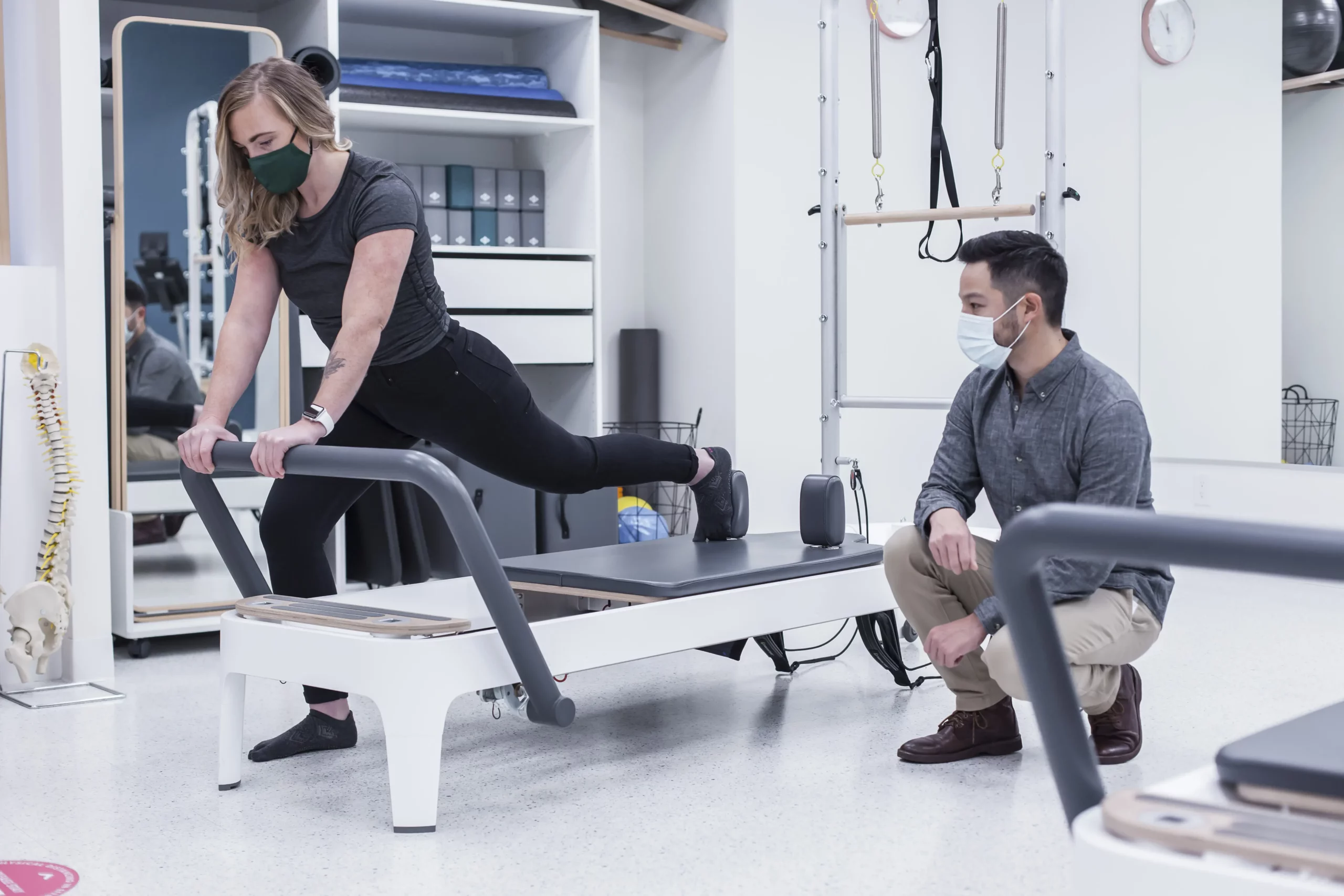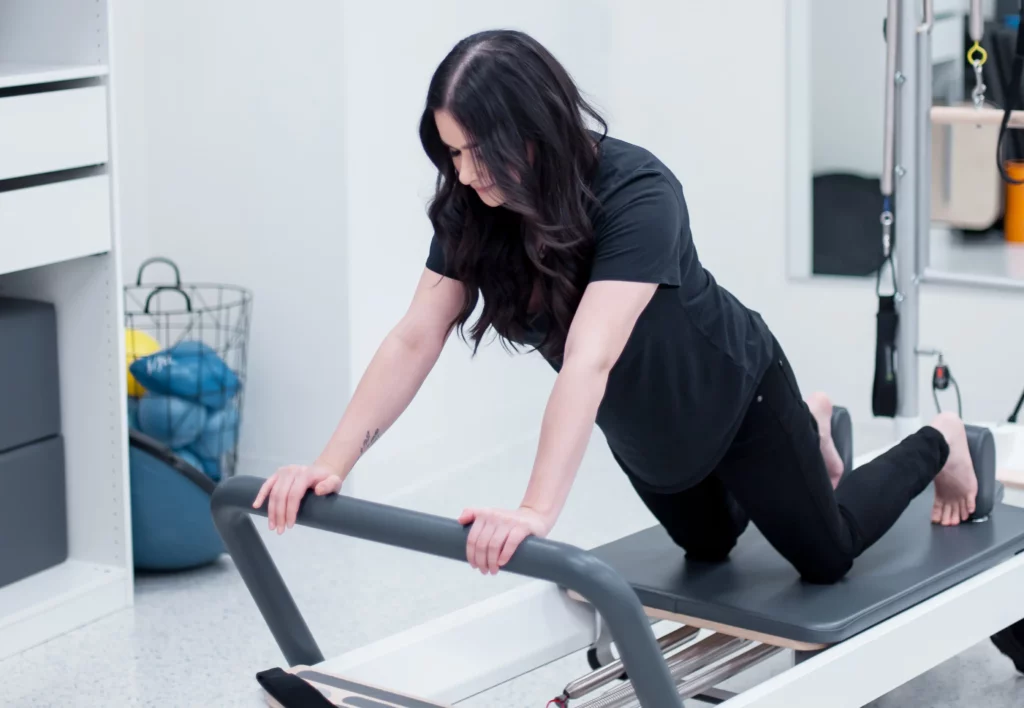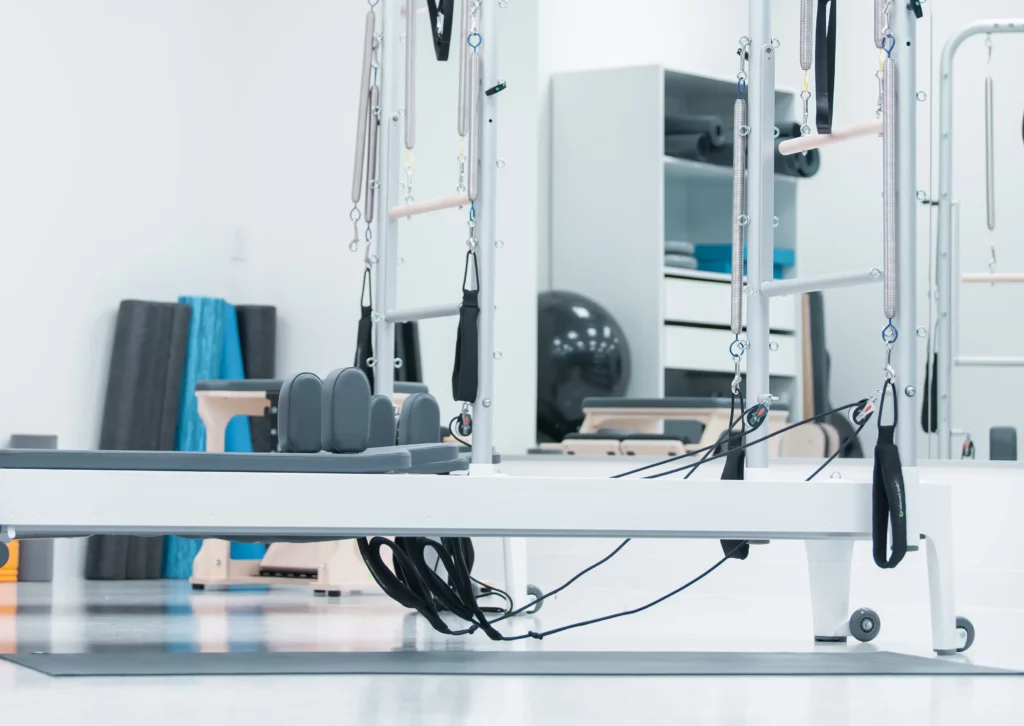In today’s fast-paced world, where we often find ourselves sitting for long hours at work or slouching over our smartphones, it’s no wonder that poor posture and back pain have become increasingly common issues.
Fortunately, there are solutions that can help you improve your posture, alleviate back pain, and enhance your overall well-being: physiotherapy and Clinical Pilates. These two approaches, when used together, can address the root causes of your discomfort, leading to longer lasting relief and improved overall well-being.
At Reformotiv Physio + Pilates, we specialize in both of these services, so we wanted to create this article to discuss how they can work together to help you overcome back pain and posture-related issues.
The Role of Physiotherapy in Addressing Back Pain and Posture
Physiotherapy is focused on assessing, diagnosing, and treating a wide range of musculoskeletal conditions, including back pain and postural problems. Physiotherapists use various techniques, such as manual therapy, exercise prescription, and education, to help individuals restore mobility, decrease pain, and improve posture.
In the context of back pain and posture, physiotherapy can help by:
- Identifying the underlying cause of your pain or postural problem, such as muscle imbalances, joint restrictions, or movement dysfunctions
- Developing a personalized treatment plan that targets your specific needs and functional goals
- Providing hands-on manual therapy to release tight muscles, mobilize stiff joints, and facilitate better alignment
- Educating you on optimal body mechanics, ergonomics, and self-management strategies to prevent future issues

The Benefits of Clinical Pilates for Back Pain and Posture
Clinical Pilates offers numerous benefits for those seeking to improve their posture and alleviate back pain. Some of these benefits include:
Strengthening Muscles Around the Spine
One of the key principles of Clinical Pilates is the focus on strengthening the muscles that support the spine. By targeting these muscles, you can create a strong and stable foundation for your spine, which can lead to improved posture and reduced back pain.
Enhancing Core Strength and Stability
A strong and stable core is crucial for maintaining proper posture and preventing back pain. Clinical Pilates exercises are designed to engage and strengthen the deep core muscles, such as the transversus abdominis and multifidus, which help to support the spine and maintain optimal alignment. Our upper and lower extremities also feed into our core (and vice versa) so it is important to use holistic movement practices – like Pilates – to facilitate a strong and functional core.
In a study published in the Journal of Orthopaedic & Sports Physical Therapy, researchers looked at how various exercise interventions provided benefits for managing pain and disability in chronic low back pain (LBP). However, the most effective programs included:
- Pilates or strength exercises conducted at a frequency of 1 to 2 sessions per week
- Core-based, strength, or mind-body exercises with session durations of less than 60 minutes
- Pilates and core-based exercise programs with a duration of 3 to 9 weeks.
Promoting Optimal Alignment
Clinical Pilates emphasizes the importance of optimal alignment in all exercises to help improve your efficiency of movement. Physiotherapists trained in Clinical Pilates use hands-on techniques such as facilitating muscles and guiding joints as you move to help retrain your motor patterns. These techniques support quick and lasting motor learning in your body, ultimately reducing pain and getting you back to sports and activities quickly.
A study published in the Journal of Bodywork and Movement Therapies examined the effects of Pilates on postural alignment in adults. Sixty participants with poor posture were randomly assigned to either a Pilates group or a control group. The Pilates group attended a 12-week program, while the control group received no intervention. The results showed that the Pilates group experienced significant improvements in postural alignment, including reduced head and shoulder protrusion and increased thoracic extension. This study highlights the potential of Pilates to improve posture and reduce postural-related issues.

How Physiotherapy and Clinical Pilates Work Together for Optimal Results
When combined, physiotherapy and Clinical Pilates create a powerful and synergistic approach to addressing back pain and postural issues. Physiotherapy provides the foundation by identifying the root causes of your discomfort and developing a customized, hands-on treatment plan to address them. Meanwhile, Clinical Pilates builds on this foundation by strengthening and stabilizing the key muscles that support your spine, ultimately leading to lasting improvements in posture and function and a reduction of pain.
Here’s a step-by-step overview of how these two approaches can work together:
- Assessment: Your physiotherapist will conduct a thorough assessment to determine the underlying cause of your back pain and postural problems.
- Treatment Plan Development: Based on the assessment findings, your physiotherapist will create a personalized treatment plan that includes manual therapy, exercise prescription, and education. Rehab goals will be created that reflect your unique needs and concerns and support you wherever you are in your movement journey.
- Physiotherapy Sessions: You’ll attend regular physiotherapy sessions to receive hands-on treatment and guidance on exercises and strategies to improve your posture and alleviate pain.
- Clinical Pilates Integration: Once your pain is under control and you have a solid understanding of the foundational exercises, your physiotherapist may recommend incorporating Clinical Pilates into your treatment plan.
- Clinical Pilates Sessions: You’ll work with your Clinical Pilates trained Physiotherapist, where you’ll perform targeted exercises designed to strengthen your core, stabilize your spine, and promote optimal alignment. Your Physiotherapist will use their unique understanding of anatomy, physiology, and motor learning to support your injuries and concerns through functional movement retraining.
- Progress Monitoring: Your physiotherapist will regularly monitor your progress, adjusting your treatment plan and Clinical Pilates exercises as needed to ensure optimal results that meet your goals.

5 Clinical Pilates Exercises and Stretches for Back Pain
1. Pelvic Tilt
Target Areas: Lower back, abdominals, and pelvic floor muscles
Benefits: Improved posture, reduced lower back pain, and enhanced pelvic stability and mobility
- Lie on your back with knees bent and feet flat on the floor, hip-width apart.
- Inhale deeply and, as you exhale, engage your abdominal muscles and tilt your pelvis upward.
- Hold the position for a few seconds, then inhale and return to the starting position.
- Repeat 8-10 times.
2. Spine Twist
Target Areas: Abdominals, obliques, and lower back
Benefits: Increased spinal mobility, better posture, and enhanced core strength
- Sit tall with legs extended in front of you, hip-width apart.
- Extend your arms out to the sides at shoulder height.
- Inhale and, as you exhale, twist your torso to one side, keeping your hips stable.
- Inhale to return to center, then exhale to twist to the other side.
- Repeat 8-10 times on each side.
3. Bridge
Target Areas: Glutes, hamstrings, and lower back
Benefits: Improved hip stability, stronger glutes, and reduced lower back pain
- Lie on your back with knees bent and feet flat on the floor, hip-width apart.
- Inhale deeply and, as you exhale, lift your hips off the ground, pressing into your feet and reaching through your knees
- Hold the position for a few seconds, then inhale and lower your hips back to the starting position.
- Repeat 8-10 times.
4. Cat-Cow
Target Areas: Spine, abdominals, and neck
Benefits: Enhanced spinal flexibility, reduced tension in the neck and shoulders, and improved posture
- Begin on your hands and knees, with wrists directly under shoulders and knees under hips.
- Inhale and arch your back, lifting your chest and tailbone toward the ceiling (Cow).
- Exhale and round your spine, tucking your chin and tailbone under (Cat).
- Repeat 8-10 times, moving smoothly between the two positions.
5. Swan Prep
Target Areas: Upper back, lower back, and abdominals
Benefits: Improved posture, increased spinal mobility, and enhanced back strength
- Lie face-down with your arms bent, hands under your shoulders, and legs straight.
- Press into your hands as you lengthen your spine. Inhale to lift your head and chestoff the ground, engaging your back muscles.
- Exhale and lower your upper body back down.
- Repeat 8-10 times.
Conclusion
Combining physiotherapy and Clinical Pilates offers a comprehensive and highly effective solution for addressing back pain and postural issues. By working together, these two approaches can help you achieve long lasting relief, improved posture and body awareness,and enhanced overall well-being.
If you’re struggling with back pain or poor posture, come visit the team at Reformotiv Physio + Pilates in Vancouver.
References
Cruz-Ferreira, A., Fernandes, J., Laranjo, L., Bernardo, L. M., & Silva, A. (2011). A systematic review of the effects of pilates method of exercise in healthy people. Journal of Bodywork and Movement Therapies, 15(4), 528-534.
Fernández-Rodríguez R, Álvarez-Bueno C, Cavero-Redondo I, Torres-Costoso A, Pozuelo-Carrascosa DP, Reina-Gutiérrez S, Pascual-Morena C, Martínez-Vizcaíno V. Best Exercise Options for Reducing Pain and Disability in Adults With Chronic Low Back Pain: Pilates, Strength, Core-Based, and Mind-Body. A Network Meta-analysis. J Orthop Sports Phys Ther. 2022 Aug;52(8):505-521. doi: 10.2519/jospt.2022.10671. Epub 2022 Jun 19. PMID: 35722759.

